Post Fifteen - Fiji and the Equator
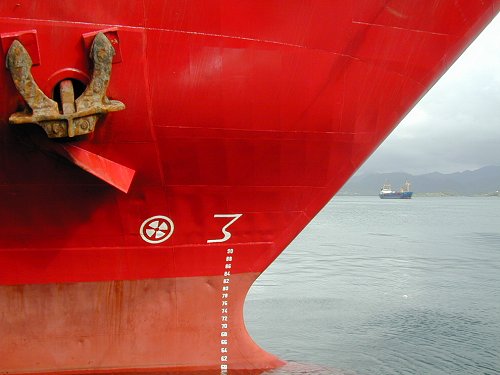 Fiji FijiWe arrived in Fiji about a week after leaving New Zealand. After being aboard with nothing to do for that long it was nice to have a place to stretch my legs. Plus, I was in Fiji! Although, I really wasn't in the part of Fiji you picture- white sand, clear water, etc. I was in Suva, the gritty, rainy port that is the country's capital. We had 24 hours here while we unloaded and loaded. I wandered the streets - examining the strange mix of cultures and enjoyed the sensation of being ashore yet being a transient. The idea that I would be leaving by ship in 24 hours made me look at the people and the country in a different light. I thought "I'm just a visitor here. Let me soak up as much as I can before I have to leave." In a sense, it's what I've felt in every country and, to an extent, in life. This is a photo of the ship that was docked next to us in the Suva harbor. |
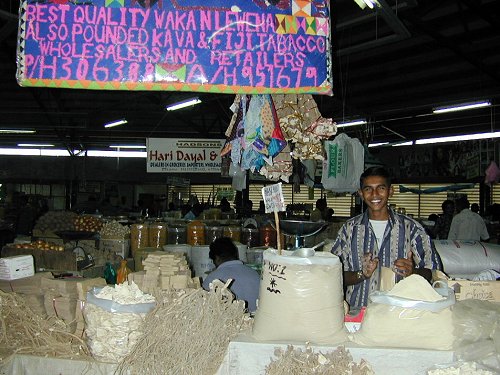 Kava KavaKava is a root that when pounded into a pulp and mixed with water forms a muddy, dirty tasting brown liquid. It's also mildly narcotic. When I was in Micronesia many years ago, I had the opportunity to try Kava in a small village in Pohnpei. I remembered drinking several Dixie cups of it with a village elder in the town I visited. As the night continued on, our conversation became muted and the men playing a guitar and Casio keyboard in the corner transformed from an annoying repetitive din to a melodic harmony. The Christmas lights strung up added an exotic feel that mixed with the tropical night air. I felt the history of the islands engulf me and transport me back to the age when the natives were astounded by the sight of white men who were astounded by the natives. Centuries of communication passed between my host and I without either of us speaking. It is a night that is etched in my memory. I was on my way to San Francisco to see Brock - one of the people (next to Karen) I wanted to see most upon returning home. Always up for an experience, I thought I would bring him a present. In Fiji, Kava is sold by the Kilo (which is a lot). I entered the market and passed stall after stall of fruits, vegetables, and baked goods without finding any Kava. I asked someone if they sold Kava in the market. He looked at me funny and said "Sure, upstairs." When I climbed the ramp I saw a huge Kava market with stalls as far as the eye could see. There was pounded kava, raw kava, strong kava, mild kava, kava bricks and kava bark. I ordered a kilo of the good stuff and hurried back to the boat to make the sailing. This is a photo of my vendor. |
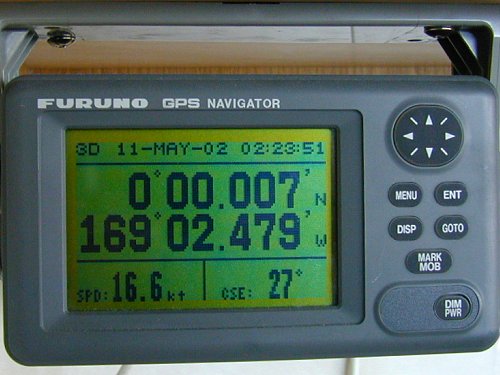 The Equator The EquatorCrossing the equator at sea is a pretty major event to sailors. In the old days it meant you were in the upper echelon of sailors to travel so far from home. Today, even with GPS positioning and modern vessels it's still impressive. It certainly was for me. I'd crossed the equator on the ship from Singapore to Australia but that was at night and with no fanfare. This time we crossed the equator around noon and it was different. I was on the bridge when we crossed. I tried to get a shot of the GPS as we crossed. I then ran outside but was too late to get a shot of the red line in the ocean. |
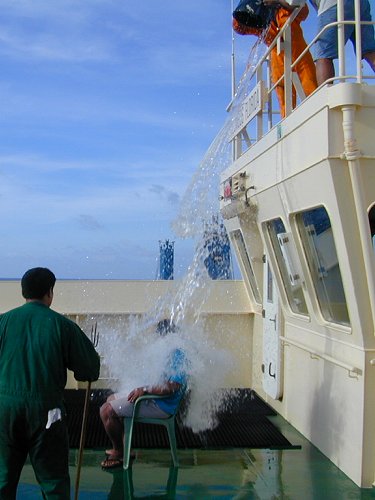 Crossing the Line Crossing the LineSailors who have never crossed the equator before are called pollywogs. Those who have crossed are called shellbacks. There is a sort of initiation ceremony when you cross the line on a ship. The current certificate-holding shellbacks on board assist in the ceremony and ensure the pollywogs are worthy. More than that I'm not allowed to divulge. |
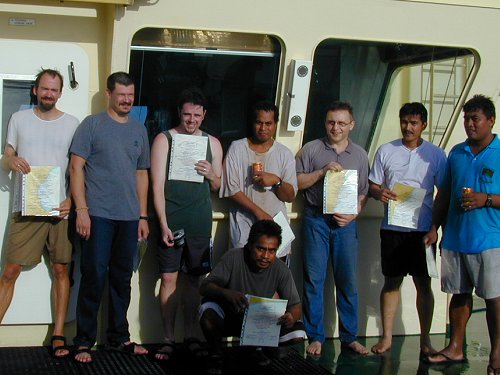 New Shellbacks New ShellbacksOnce you have crossed the equator and have been accepted as a shellback you get a certificate to show your new status. When I cross the equator next, I'll be sure to bring my certificate so that I may assist in the ceremonies certifying the new initiates. |
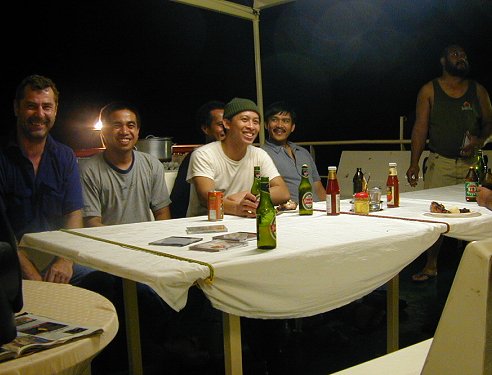 Fantail Barbeque Fantail BarbequeThe evening after our equator crossing we held a barbeque on the fantail (the rear of the ship). There was ample food and drink and everyone was in a festive mood. At the equator, the sun goes down fast so it got dark quickly. I remember drinking beers, throwing the empties into the ocean and laughing with my new friends as we steamed toward home under a canopy of millions of stars. |
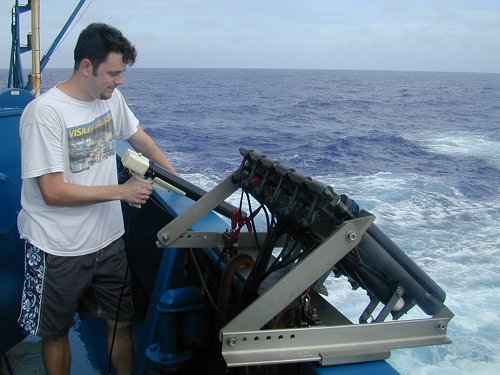 Oceanography OceanographyI was not the only passenger on board. Josh was also aboard as part of an oceanographic experiment studying sea temperatures between New Zealand and Hawaii. He had a crate of XBDs on board (eXpendable Bathometry and Depth transceivers) and had a contraption that would shoot them into the water off the back of the ship every 4 hours or so. Once a day he would shoot off a more expensive model that also measured salinity. These are about $1000 each and are used only once. They drop into the water and sink through the depths sending back their information over a hair-thin wire that spools out quickly as the ship steams onward. Once they reach the end of the wire it snaps from the spool and the device continues it's descent to the ocean floor 2 kilometers below. Here is a shot from the computer that takes the readings. The left hand side is the depth and the two lines are the graph of salinity and temperature. |
Next Up: Repatriation
Copyright 2003
Scott & Karen Semyan